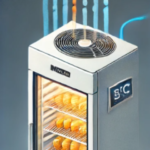 Cooking appliance heat sensors ensure precise temperature management in commercial kitchens. These sensors, made up of a fluid-filled bulb and capillary tube assembly, detect and transmit temperature changes to the OEM’s custom control system. The system then adjusts heating elements in appliances like gas fryers, ovens, and grills, maintaining consistent cooking temperatures.
Cooking appliance heat sensors ensure precise temperature management in commercial kitchens. These sensors, made up of a fluid-filled bulb and capillary tube assembly, detect and transmit temperature changes to the OEM’s custom control system. The system then adjusts heating elements in appliances like gas fryers, ovens, and grills, maintaining consistent cooking temperatures.
OEMs integrate these sensors into their appliances to achieve accurate heat control and reliable operation in high-temperature environments. Built to handle the demands of commercial kitchens, these sensors offer durability and performance for consistent cooking results.
Looking to enhance your appliance designs? Contact us today to learn how our cooking appliance heat sensors can support your custom control systems. Visit the product page for additional information.
Applications for Cooking Appliance Heat Sensors
1. Gas Fryers
Cooking appliance heat sensors maintain consistent oil temperatures in gas fryers.
- How They Work: The fluid-filled bulb sits in the fryer oil, monitoring its temperature. The capillary tube sends pressure signals to the control system, which adjusts the heating element to maintain the target temperature.
- Why It’s Effective: The sensor prevents overheating and ensures oil stays within the optimal range for frying.
2. Ovens
Commercial ovens rely on heat sensors for precise baking and roasting temperatures.
- How They Work: The bulb is installed inside the oven cavity to measure temperature changes. Signals from the capillary tube reach the control system, which adjusts heating cycles to maintain consistent heat.
- Why It’s Effective: Sensors ensure even cooking and reduce energy consumption by maintaining steady oven temperatures.
3. Grills
Appliance heat sensors manage surface temperatures in grills, ensuring consistent cooking.
- How They Work: The bulb is positioned near the cooking surface to monitor heat levels. The capillary tube transmits this data to the control system, which modulates the heating elements.
- Why It’s Effective: Sensors provide uniform heat distribution and prevent grilling surfaces from overheating.
Why OEMs Use Heat Sensors
OEMs incorporate heat sensors into their appliances to improve temperature regulation and meet performance standards. These sensors offer:
- Customizable Features: Adjust bulb size, capillary tube length, and fluid type for specific appliance designs.
- Accurate Response: Fluid-filled bulbs provide smooth pressure signals, enabling precise adjustments by the control system.
- High Durability: Designed to handle extreme temperatures and frequent use in commercial kitchens.
- Seamless Integration: Sensors easily connect to custom control systems for fryers, ovens, and grills.
Benefits for Commercial Kitchen Appliances
- Improve Cooking Consistency: Maintain steady heat for uniform cooking results.
- Enhance Safety: Prevent overheating of oil, air, or cooking surfaces.
- Reduce Energy Use: Activate heating elements only when necessary, lowering energy costs.
- Extend Appliance Life: Protect heating components by preventing excessive temperature fluctuations.
Cooking appliance heat sensors give OEMs the tools to design high-performing commercial kitchen appliances. These sensors deliver reliable heat management, ensuring cooking quality and equipment durability.



